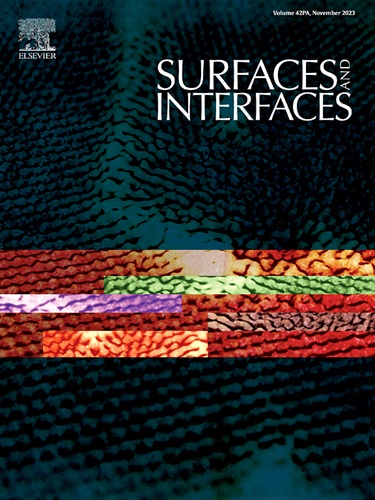A robust superhydrophobic-superoleophilic stainless steel mesh with superior mechanical durability and chemical stability for oil-water separation
IF 5.7
2区 材料科学
Q2 CHEMISTRY, PHYSICAL
引用次数: 0
Abstract
The dumping of industrial oily waste water and regular oil spills have become more conspicuous. Effectively separating oil/water mixtures to protect and reuse water resources is an important issue in the global scientific community. Therefore, developing durable, high-throughput materials for oil/water separation is essential. This study employs a convenient, quick, and environmentally friendly one-step electrodeposition method to prepare a zinc-cobalt stearate (STA-Zn/Co) composite-coated mesh on stainless steel. Structural analysis of the coating was conducted using SEM (Scanning Electron Microscopy), CLSM (Confocal Laser Scanning Microscopy), XPS (X-ray Photoelectron Spectroscopy), and XRD (X-ray Diffraction) technologies, and tests were performed on the wettability and robustness of the composite mesh. It turned out that the optimal STA-Zn/Co mesh exhibits optimized biomimetic structure and mechanical stability, with outstanding wettability (WCA = 161.0±0.2°, WSA = 6.0°, OCA = 0°), which holds potential for oil-water separation. The STA-Zn/Co mesh was used in oil/water separation trials for various oil-water pairs, with a separation efficiency exceeding 94 %. In addition, the STA-Zn/Co mesh exhibits remarkable self-cleaning capabilities, stability, and resistance to both acidic and alkaline environments, along with corrosion resistance. Therefore, this efficient and low-cost one-step electrodeposition method provides a promising potential approach for achieving oil-water separation.

一种坚固的超疏水-超亲油不锈钢网,具有卓越的机械耐久性和化学稳定性,用于油水分离
工业含油废水的倾倒和经常性的石油泄漏已经变得更加明显。有效分离油水混合物以保护和再利用水资源是全球科学界的一个重要问题。因此,开发用于油水分离的耐用、高通量材料至关重要。本研究采用一种方便、快速、环保的一步电沉积方法,在不锈钢表面制备硬脂酸锌钴复合涂层网片。采用SEM(扫描电子显微镜)、CLSM(共聚焦激光扫描显微镜)、XPS (x射线光电子能谱)和XRD (x射线衍射)技术对涂层进行结构分析,并对复合网格的润湿性和鲁棒性进行测试。结果表明,优化后的STA-Zn/Co网具有优化的仿生结构和力学稳定性,具有良好的润湿性(WCA = 161.0±0.2°,WSA = 6.0°,OCA = 0°),具有油水分离的潜力。采用STA-Zn/Co网对不同油水对进行油水分离试验,分离效率达94%以上。此外,STA-Zn/Co网具有显著的自清洁能力,稳定性,耐酸性和碱性环境,以及耐腐蚀性。因此,这种高效、低成本的一步电沉积方法为实现油水分离提供了一种很有潜力的方法。
本文章由计算机程序翻译,如有差异,请以英文原文为准。
求助全文
约1分钟内获得全文
求助全文
来源期刊

Surfaces and Interfaces
Chemistry-General Chemistry
CiteScore
8.50
自引率
6.50%
发文量
753
审稿时长
35 days
期刊介绍:
The aim of the journal is to provide a respectful outlet for ''sound science'' papers in all research areas on surfaces and interfaces. We define sound science papers as papers that describe new and well-executed research, but that do not necessarily provide brand new insights or are merely a description of research results.
Surfaces and Interfaces publishes research papers in all fields of surface science which may not always find the right home on first submission to our Elsevier sister journals (Applied Surface, Surface and Coatings Technology, Thin Solid Films)
 求助内容:
求助内容: 应助结果提醒方式:
应助结果提醒方式:


